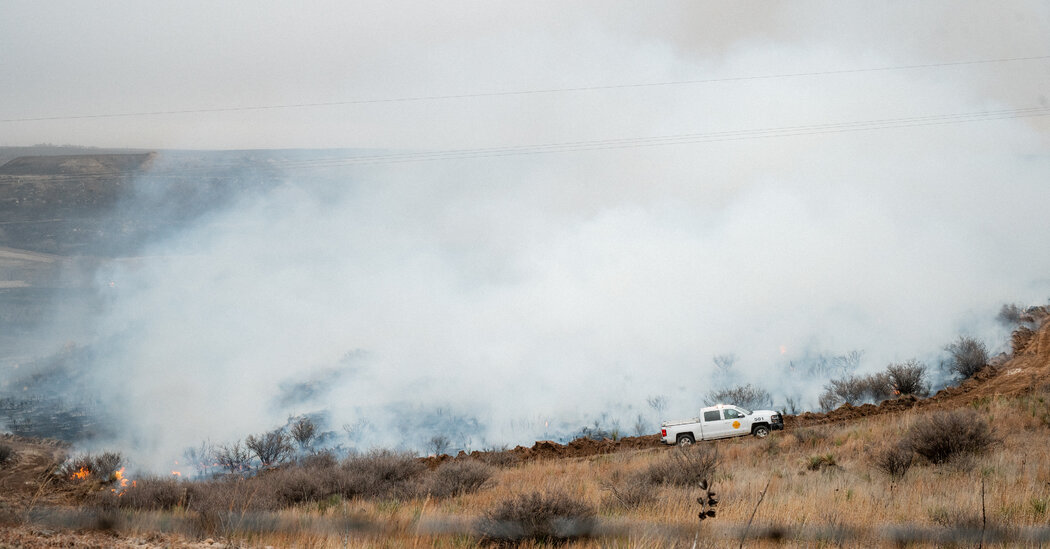
 News
News 
The Smokehouse Creek fire, the largest on record in Texas, is still largely uncontrolled across the state’s Panhandle.
So far, the fire has scorched more than a million acres, making it one of the most destructive in U.S. history. The blaze has devastated cattle ranches, consumed homes and killed at least two people. More hot, dry weather over the weekend threatens to worsen conditions.
Here is what we know so far.
The blaze was ignited on Monday, and it’s not yet clear what started it.
It spread around the town of Canadian, a cattle-country community of around 2,200 people northeast of Amarillo, near the Oklahoma state line. By Wednesday, the fire had spread across vast swaths of ranch lands in the Panhandle. By Thursday, it had become the largest on record in the state.
In order to grow so quickly, a few weather conditions had to align: high temperatures, dry conditions and strong winds.
On Monday, it was 82 degrees in Amarillo. The average daytime high temperature there in February is 54 degrees, according to the National Weather Service.
The Smokehouse Creek fire has been burning across a sparsely populated area of Texas that is home to most of the state’s cattle: millions of cows, calves, steers and bulls. Its sprawling ranches are not always easily traversable by road.
Wildfires are nothing new for Panhandle ranchers, many of whom know how to transform their pickups into makeshift fire trucks in order to fight a blaze. But the scale of this fire is without precedent in Texas.
In addition to the ranchers, residents of the small communities that dot the landscape, like Fritch and Canadian, have seen their homes, cars and churches reduced to rubble.
Two deaths have been connected to the fires so far. Joyce Blankenship, an 83-year-old woman living on the outskirts of the town of Stinnett, perished in her home when flames overtook her property on Tuesday. Cindy Owen, 44, died from burns after flames surrounded her company truck on Tuesday as she drove home to Amarillo from Oklahoma. She later died at a hospital.
The Smokehouse Creek fire was 15 percent contained as of Friday morning, the authorities said.
The rugged terrain of the Canadian River Valley, where the fire started, has been a major obstacle for firefighters because fire trucks cannot navigate some of the cliffs, valleys and steep hills in the area.
Some rain on Thursday helped to stall the fire’s growth. But warm, windy and dry weather was expected to return over the weekend, which could prolong the blaze.
The National Weather Service warned of “critical fire weather conditions” in the region on Saturday — Texas Independence Day — and Sunday, urging residents to avoid outdoor activities that might cause sparks or flames.
A fire weather watch was posted for Saturday afternoon through Sunday evening, covering the Texas Panhandle and nearby parts of Oklahoma.
The Panhandle is home to about 85 percent of the roughly 12 million cattle in Texas, said the state agriculture commissioner Sid Miller. But most of them are kept concentrated in feedlots and dairy farms, and those operations have been largely unaffected by the fires.
Still, wide swaths of the grassland that Texas cattle rely on for food have been reduced to a blackened expanse. Thousands of cattle may have already died, or been so injured in the blazes that they would have to be killed, Mr. Miller said.
Even those ranchers whose cattle have survived were left scrambling for a place for their herds to eat. Mr. Miller said a rancher he knew had 1,500 head of steer but “no grass and no water” and was in a desperate situation, adding that the rancher may have to move the cattle across state lines.
In most of Texas, wildfires happen in the summer. But in the Panhandle, the fire risk is highest around March when temperatures rise, strong winds blow over the flat landscape and dry grass can easily catch fire.
Climate change is most likely making fire season start earlier and last longer by increasing the number of days in a year with hot and dry weather conditions that enable wildfires, said John Nielsen-Gammon, the Texas state climatologist and a professor of atmospheric science at Texas A&M University.
Temperatures in Texas have risen by 0.61 degrees per decade since 1975, according to a 2021 report by the state climatologist’s office. The relative humidity in the Panhandle region has been decreasing as well.
Reporting was contributed by Delger Erdenesanaa, Christopher Flavelle, Lucinda Holt and Miglena Sternadori.
24World Media does not take any responsibility of the information you see on this page. The content this page contains is from independent third-party content provider. If you have any concerns regarding the content, please free to write us here: contact@24worldmedia.com